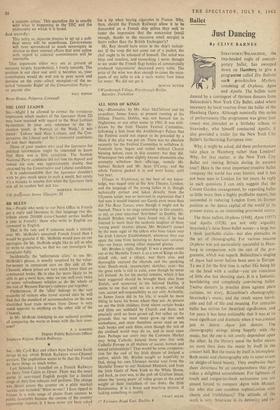Ballet
Just Dancing
By CLIVE BARNES STRAVINSKY/ BALANCHINE, the two-headed eagle of contem- porary ballet, has swooped down on Hamburg to give a programme called Die Ballette each griechischen Mythen, consisting of Orpheus, Agon and Apollo. The ballets were danced by a contingent of thirteen dancers from Balanchine's New York City Ballet, aided where necessary by local reserves from the ballet of the Hamburg Opera. Although nominally this series of performances (the programme was given four times) was .intended as a birthday tribute to Stravinsky, who himself conducted Apollo, it also provided a trailer for the New York City Ballet's forthcoming European tour.
Why, it might be asked, did these performances take place in Hamburg rather than London? Why, for that matter, is the New York City Ballet not visiting Britain during its autumn tour? Here is the most important creative ballet company the world has ever known, and it has not been seen in London for ten years. In reply to such questions I can only suggest that the Covent Garden management, by regarding ballet as little more than a highly profitable export, has succeeded in reducing Lortdon from its former position as the dance capital of the world to its present status as an interesting provincial centre.
The three ballets, Orpheus (1948), Agon (1957)' and Apollo (1928), are not only arguably Stravinsky's three finest ballet scores—a large but I think justifiable claim—but also pinnacles in the art of choreography. For various reasons Orpheus was not particularly successful in Ham- burg in comparison with the rest of the pro- gramme, which was superb. Balanchine's staging of Agon had never before been seen in Europe. To see it for the first time is rather like being hit on the head with a mallet—you are conscious of little else but shooting stars. It is a fantastic, bewildering and completely convincing ballet. Twelve dancers in practice dress against plain curtains, no story, Balanchine's choreography, Stravinsky's music, and the result seems inevit- able and full of life and meaning. For centuries ballet has striven for theatrical significance, and for years it has been noticeable that it was at its most significant and dramatic when it was content just to dance. Agon just dances. The choreography strings along happily with the music, but the one is not overly dependent upon the other. In the literary sense the ballet means no more than does the music by itself in the concert hall. But the music by itself is incomplete. Both music and choreography rely to some extent on sleight-of-hand beauty. They emphasise their sheer cleverness by an unexpectedness that pro- vokes a delighted astonishment. For lightness of touch and tongue-in-cheek seriousness you are almost forced to compare Agon with Mozart, for who else can combine sophistication with charm' and truthfulness,?' The attitude of the work is very American in its dexterity and ex-
pertise, although its ravishing classic elegance is both timeless and homeless.
This work of genius was marvellously danced by the New York City Ballet soloists, as was Apollo which, conducted by Stravinsky himself, ended the programme. Apollo, the first-born of the neo-classical revival, is a landmark. Yet unlike most artistic landmarks it is a joy in itself, a great ballet that has matured with age. At the end Stravinsky and the dancers were applauded and applauded and applauded. It suddenly made me intensely hopeful for the future of ballet; I felt like exploding with gratitude for this old man, the young dancers and the absent but ever-present Balanchine.











































 Previous page
Previous page